► Meet the new, all-electric Volvo EX90 SUV
► Safety tech galore, bi-directional charging
► Huge 111kWh battery for 373-mile range
Volvo has revealed its forthcoming EX90 SUV will use a new, higher definition version of Google’s mapping software. Designed exclusively for OEMs, Google’s new, high-res map data will provide lane-level and localisation information – crucial for autonomous driving. When combined with the EX90’s lidar, radars, cameras and sensors – as well as Nvidia’s Drive AI platforms Xavier and Orin – the maps should enable a seamless assisted-driving experience in Pilot Assist-enabled cars.
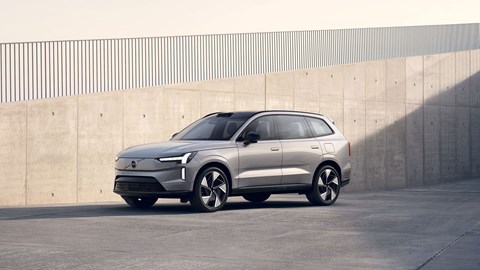
The news also means Google’s car software now matches Here maps, which already has HD map data.
‘Building on our long history of mapping the world, Google’s new HD map is designed specifically for automakers and provides comprehensive lane-level and localisation data that is crucial to powering the next generation of assisted and autonomous driving systems,’ said Jorgen Behrens, vice president and general manager of Geo Automotive, Google. ‘We’re excited to continue partnering with leading automakers such as Volvo Cars to improve the safety and comfort of drivers everywhere.’
Your £100,000 Volvo is here
The EX90, which enters production in late 2023 (the car will be built in the US and China) for first customer deliveries in 2024, simultaneously does and doesn’t replace the XC90. The XC will continue, with an EX90-alike re-skin and plug-in hybrid powertrains.
But the EX90 does succeed the XC90 as Volvo’s flagship and standard bearer. A hugely expensive and seven-seat (initially at least – a £75k entry-level version will follow, as may a version with fewer seats) electric SUV with the hardware to drive itself, it will shape the next generation of all-electric Volvo, kicking off with a small crossover in 2023.
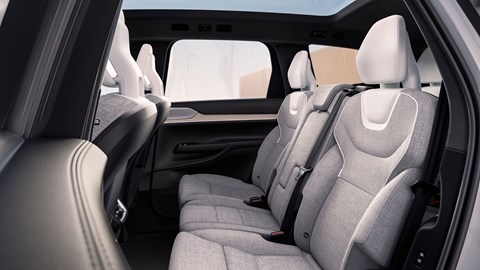
The phrase ‘The premium alternative’ is reborn Volvo’s mission statement, and certainly Gothenburg’s happy now to charge like the Germans. The EX90 launches as a near-£100,000 car, with two versions available initially: the Twin Motor Ultra (402bhp, 568lb ft, 5.9sec 0-62mph, 364-mile range) priced from £96,255, or from £1599 a month on subscription, and the Twin Motor Ultra (509bhp, 671lb ft, 4.9sec 0-62mph, 360-mile range) at a cool £100,555, or £1669 a month.
Seven seats, big screens, illuminated wood…
Given all the tech talk, including Nvidia processors and Qualcomm CPUs combining to process up to 280trillion operations per second, you might expect to find climb inside and find an interior like a server farm – all towering steel and glass boxes, pythons’ nests of cables and blinking blue lights.
For more like this, subscribe to CAR here
Well, no, fortunately. The EX90 doubles-down on the XC90’s philosophies, namely Scandinavian minimalism saved from feeling cold and empty by rich materials and jewel-like detailing. Naturally, a 15-inch central touchscreen is your portal by which to control most everything, from seat adjustment to route planning. Google-powered but CarPlay compatible and running at two and half times the speed of the XC90’s architecture, the EX90’s interface has, Volvo claims, been painstakingly evolved not to be painful to use.
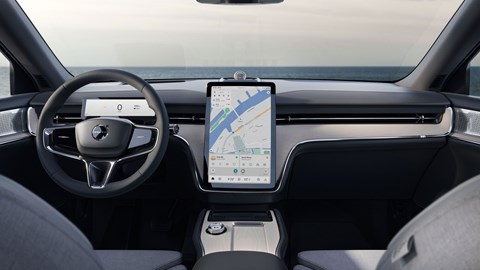
The few buttons you did find in the XC90 are gone, the EX90 re-homing them in the screen’s bottom bar of must-have functionality. Beyond that, its acreage is yours to configure as you wish, albeit with handy widgets should, for example, you suddenly want to dart back to navigation from, say, the media screen.
Your profile will be created the day you order your car, and it’ll help your Volvo (and any others you drive) get to know you, automatically dropping the climate control to your preferred cooler setting, for example, if you take the car from someone a little more cold-blooded. And it’ll know it’s you as you approach, detecting your phone, unlocking and playing out a welcome animation with the front and rear lights as you approach.
The XC’s lever-style drive selector has moved to the steering column, leaving just a play/pause volume rotary (a 3D-printed work of art in glass and metal) on the otherwise unblemished centre console, beneath which you’ll find a cubby for a bag or jacket. The detailing is £100,000-appropriate, from the mesh covers to the Bowers & Wilkins speakers to illuminated wood on the doors and dash panel. The traditional instrument binnacle is gone, replaced with a crisp and starkly de-contented view (an option, though it can also display a dynamic rendering of the surrounding road environment, complete with little amorphous Polestar 2s as avatars for everyone else) that looks for all the world like your iPhone laid landscape.
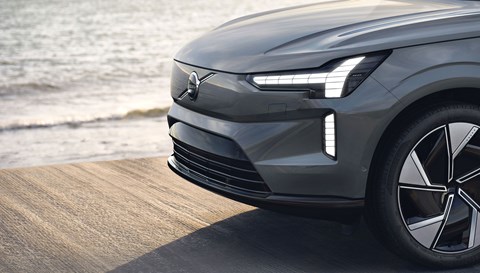
Leather isn’t an option, of course, with a number of more sustainable/Scandinavian trim options – including a pretty convincing substitute that combines pine sap and recycled plastic – for all seven very lovely seats. The EX90 was designed from the ground-up and inside-out to be a seven-seater par excellence, and it’s this – together with the less ostentatious design aesthetic – that distances the Volvo from the Polestar 3, which sits on the same SPA2 platform. Relative to the XC90, much hardware has been cleared from the cabin, which gains a flat floor and whole galaxies of space by virtue of the EV powertrain.
£100,000 isn’t far off Bentley money, and the EX90 will be up against BMW’s comparable flagship, the iX. The Volvo feels as special inside, and its evolution of the XC90’s uncluttered luxury is compelling; desirable, zeitgeisty, modern. It’s an understated lesson in how to do it, and when Bentley’s design director tells you he wants to de-clutter Crewe’s cabins, you wonder if he has something like this in mind.
Time to believe in autonomous driving…
You won’t have missed the EX90’s lidar sensor. It sits proudly on the leading edge of the roof, with the message ‘Volvo for life’, and looking for all the world like an off-duty taxi light.
It’s not pretty (design director Robin Page considered putting it behind the windscreen or burying it in the front end of the car, but accepted that both solutions would impair its performance) but it’s billed as a gamechanger. Standard fitment, it’s the headline act in a comprehensive array of sensors and cameras, the information from which is processed by the EX’s computational might and understood by Volvo’s own in-house software.
Volvo autonomous tech: what you need to know about the ‘digital seatbelt’
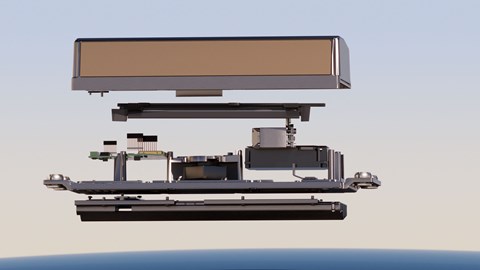
The combination of wildly powerful silicon chips, sensors and in-house perception software is nothing less than ‘the digital seatbelt’ according to Volvo CEO Jim Rowan. And he’d know – Volvo famously invented the three-point seatbelt, back in the ’50s, and the innovation has likely saved hundreds of thousands of lives since.
The promises are almost as significant this time around, with Rowan talking of a 20% reduction in accidents causing death and serious injury. And the systems that’ll achieve this are the same as those that will, when the time comes, drive your EX90 for you. Rowan won’t be drawn on when, exactly, Volvo will go live with hands-off-the-wheel driving – only that it will be ‘within a reasonable timeframe’, and that the barrier remains firmly ‘regulatory’.
We’ve been here before, of course. Many times. But what’s different this time around, according to Volvo and its partners at least, is that the hardware, software and processing power are now up to the task. Where many existing collision mitigation systems are faintly hopeless, triggering needlessly and failing to cope with tricky so-called ‘edge’ events, it’s claimed the EX90’s spec moves us one step closer to napping-on-the-M25 utopia.
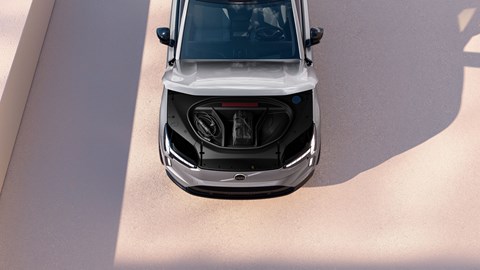
‘The “perception stack” as we call it, the hardware we’re using and the software that we write, will allow us to kick up through the metaphorical gears all the way up to autonomous driving,’ explains Rowan.
It’s these big steps forward that give Rowan the confidence to back Volvo’s course to autonomous driving – not a decision he took lightly given the risk to the company’s cast-iron safety reputation from any repeats of the kind of well-publicised incidents that have blighted other autonomous driving systems…
What are the autonomous tech levels?
‘We’ll continue to improve our assistance system, Highway Pilot and then, where legislation allows, we can move to full autonomous driving. But here’s the nub of it. We’re using the Nvidia chipset, and really car companies are starting to understand silicon for the first time. You have the application layer, so that’s lidar, cameras and sensors, and the software that connects that to the silicon. That – the software – is the part we really care about. For us, that’s the digital seatbelt, quite frankly. So, we write that. I’ve set up a team of over 700 people that write the perception software and the sensor fusion software. I think in other cases – and I don’t know about other companies – but in other cases, they have outsourced that. And that’s something we think is absolutely core.’

Austin Russell, CEO of Luminar, the firm suppling the EX90’s lidar array, is adamant the technology represents a step change. ‘We’re talking about a reaction time of one tenth of a second – it’s superhuman. We’re talking about a 700% increase in the number of collisions this system can avoid. You’d think we’d have solved this issue – of cars running into things – by now but that’s not the case. Cameras and radar systems aren’t perfectly accurate detection system. They’re slamming on the brakes all the time at nothing and then cruising on through when there is something there. The key with lidar is that you can trust it. For the first time now we’re in a place where, if it says, “Look out!” there really is something there.
Lots of range, lots of weight
The EX90 is, quite predictably, the safest car Volvo’s ever built. But, at 2818kg, it’s also the heaviest.
Of course, it’s huge, as a comfortable, seven-seat SUV must be. But much of that weight is also the battery, a 111kWh (107kWh usable) liquid-cooled slab. It’s new technology for Volvo, as are the inverters and motors, and together they’re good for a claimed 372 miles in the Twin Motor and 366 miles in the Twin Motor Performance. For reference, those WLTP range numbers just better those of BMW’s (admittedly far sportier) iX (338-349 miles) and are on a par with Merc’s EQS SUV (362-365 miles). Naturally, all these numbers are a nonsense, but they do at least give a ballpark indication of relative range.
The best electric SUVs you can buy

While much of the engineering is playbook premium EV, the rear motor unit houses innovation. The car’s brain can naturally split power front/rear, but a clutch unit on the rear motor unit also allows for a variable left/right power split, for active torque vectoring across the rear axle. It’s a neat idea that effectively mimics the double-rear-motor set-up seen on the likes of Lucid’s Air Sapphire with a single rear motor, saving weight and money. The clutch also allows the car to de-couple the rear motor when idle (when the front motor’s doing all the work), increasing efficiency.
Sustainable… really?
What’s sustainable about a brand new, 3-tonne SUV with a battery the size of a double mattress? What indeed. If you really want to protect the planet you’d probably get out of car-making, but that’s neither viable nor attractive for Geely or, by extension, Volvo. (That said, Rowan talks of a Tesla/Solar City style mini electric eco-system, with a powerbox at home linked to your EX90 and solar panels – the EX features bi-directional charging – though Volvo’s likely to collaborate with third parties on the panels, wallboxes and power banks, rather than do them in-house.)
There’s recycling, of course. Of the steel in the EX, 15% is recycled, as is 25% of its aluminium. 15% of the plastics in the car are also recycled – a Volvo best to date.
But time and again Volvo spokespeople use the same caveat – this is the most sustainable the EX90 can be without making it less good. Sky-high customer expectation on everything from safety to tech to range does not come cheap, either fiscally or in terms of mass.
‘This is a seven-seater, and I would say that in terms of sustainability, this is the best offer you can have today,’ explains Javier Varela, COO and deputy CEO. ‘If you are a family of seven, the best way to do it is with a sustainable car like this. We are focusing on sustainable materials, leather-free, we will use for the first time this Nordico that is based on recycled material in biomaterials. We have 48kg of recycled plastics in the car, and then the aerodynamics for a car of this versatility, securing seven people sitting in a comfortable way, is best in class.’
That last point isn’t true. While the 0.29 EX90 betters trad seven-seaters like the BMW X7 (0.34), Tesla’s similarly electric, similarly seven-seat Model X has a cd of just 0.25 – substantial reward for its bolder/more challenging aesthetic.
‘We are decarbonising our full supply chain,’ continues Varela, confirming that Volvo’s on this journey rather than close to its destination, complete carbon neutrality – that’s 2040, otherwise known as the best part of two decades away.
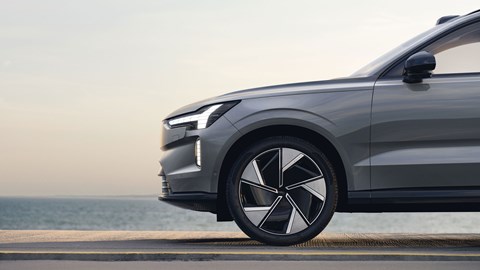
‘Referring to our plants, we are aiming to have them climate neutral, which for us means that the electricity we use is from CO2-free sources. And when it comes to gas, it’s either biogas or no gas. We are aiming at that, to be neutral for the launch [of the EX90, in early 2024]. We have committed to 2025, when all our facilities will be climate neutral. We already have plants in Europe and China that get their electricity completely from green sources. Then we have another ambition – to reduce the emissions of our suppliers; asking them to have the same behaviour as we are doing in our own plants.’
A car for now?
The EX90 arrives into a world in turmoil, not least for electric car buyers. Just as the cost of electricity soars, so governments also consider road tax on EVs for the first time, to claw back lost revenue. Lob in war, unrest, bleak climate warnings and a new John Lewis Christmas ad, and it’s enough to make you want to run for cover. The splendid isolation of an EX90 (with news alerts and the radio turned off…) looks like just the place to run to.
Volvo reviews